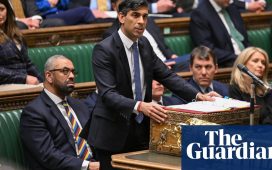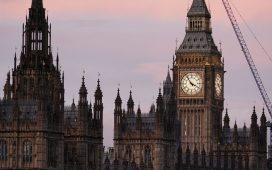Labour has accused the government of presiding over “a gulf between ambitions and actions” before a defence review on Monday expected to confirm a cut of 10,000 in the size of the British army.
The party produced figures suggesting that day-to-day defence spending will be cut by 2.4% in real terms over the course of the parliament, masked by a £16.5bn boost to the capital budget announced last November.
John Healey, the shadow defence secretary, questioned whether the planned cuts would allow the government to meet its stated goal to deploy the British military more widely “in all corners of the globe”.
“Further army cuts could seriously limit our forces’ capacity simultaneously to deploy overseas, support allies and maintain strong national defences and resilience,” Healey said. “There’s a gulf between the government’s ambitions and its actions, which is set to grow with this new review.”
The Ministry of Defence is due to publish a paper on the size and shape of the armed forces for the next five years on Monday, with ministers already emphasising that the military will be the “right size” to meet the threat.
Ben Wallace, the defence secretary, refused to deny that a planned cut in the army’s target size from 82,000 to about 72,500 soldiers was in the works when pressed on Sky News’s Sophy Ridge on Sunday.
“What I will be doing is making sure we have an armed forces that is the right size to meet the threat and the right size to meet the government’s ambition of having a global Britain that uphold values and support its allies,” the minister said.
After Brexit, ministers want Britain’s defence posture to expand, increasing its presence in the Indo-Pacific region around China, reversing a decision made by the Wilson government in 1968 to withdraw British forces from “east of Suez”. They will emphasise that, with the help of battlefield drones and communications technology able to track the position of troops on the ground, a smaller, more highly skilled army can have greater “lethality”.
An extra £200m will be given to the Royal Marines as they become a “Future Commando Force”, while the SAS and other special forces will increase in size and the army will create an upgraded Rangers regiment.
But at the Conservative party’s manifesto launch during the election campaign, Boris Johnson struck a different tone when he said there was a “sharp distinction” on defence between him and his then rival, former Labour leader Jeremy Corbyn.
“We will not be cutting our armed forces in any form. We will be maintaining the size of our armed forces because we are increasing funding for them,” Johnson told reporters at the event.
What may help the government is that, although the target size for the army will be cut, it partly reflects years of failure to recruit enough to reach it. Last April, at the beginning of the pandemic, the figure was 73,900 although it has since grown to 76,350 in January.
Labour’s calculations, based on figures published in November’s spending review, show that day-to-day defence spending will increase in cash terms from £29.7bn in 2019/20 to £31.5bn in 2021/22 but will then remain essentially flat until 2024/25, with its value in real terms gradually eroded by inflation.
Labour, under its leader Sir Keir Starmer, has been emphasising a commitment to the UK’s national security as it seeks to redefine its image after Corbyn’s four-year leadership.













